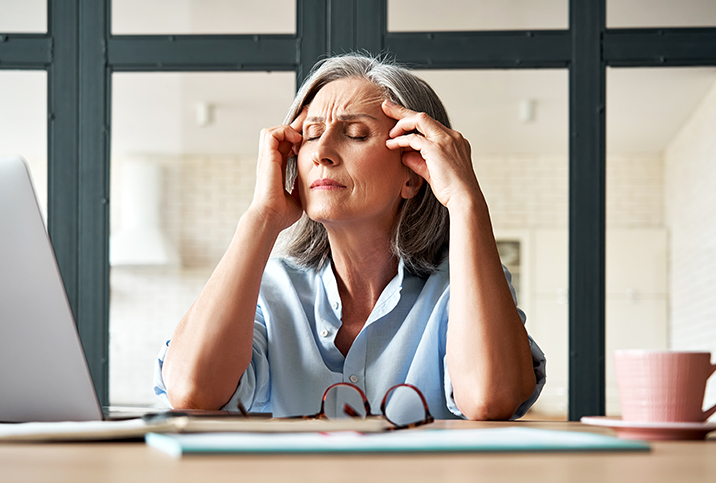New Study Casts Doubt on Laser Therapy for Treating Menopause

If taking a laser to your lady parts seems a little suspect, you're not alone. Major players in the field of women's health—the American College of Obstetricians and Gynecologists (ACOG), the North American Menopause Society (NAMS) and the Food and Drug Administration (FDA)—have publicly opposed laser therapy as a treatment for menopause. A study published in October 2021 in the Journal of the American Medical Association (JAMA) found the procedure to be no more effective than a sham treatment.
Despite all this, many practitioners are still offering this as a treatment option—and patients are ponying up thousands of dollars to get it.
How does laser therapy work for menopause?
The menopausal transition offers a host of unpleasant symptoms, but the collection of them related to the vagina is called genitourinary syndrome of menopause, or GSM. This commonly includes vaginal dryness and irritation, loss of elasticity and moisture, bleeding and infections. Among other complications, GSM can make vaginal sex uncomfortable, if not downright painful.
These happen because estrogen levels plummet during menopause, causing thinner vaginal tissue, decreased lubrication and blood flow, changes to the vaginal microbiome and inflammation, said Jacqueline Giannelli, FNP-BC, NCMP, a founding nurse practitioner at Elektra Health.
Laser therapy hasn't been FDA-approved for use in and around the vagina, but it has for treating skin, joints and other body parts. The process works essentially the same way on the genitals as on the face. A laser makes micro-ablative wounds in the tissue of the vulva and vagina. This initiates cellular repair mechanisms, stimulating the production of collagen, elastin and hyaluronic acid to repair the damaged tissue. The result is improved vaginal elasticity, tissue strength and moisture, according to proponents of the treatment.
The study found no statistically significant improvement in symptoms between the real procedure and the fake one.
In the JAMA study, some of the 85 Australian participants with GSM received actual therapy with a fractional CO2 laser and some had a placebo treatment, where a practitioner used a device that looked, sounded and felt like the real thing but provided no therapeutic benefit. The study found no statistically significant improvement in symptoms between the real procedure and the fake one.
Theoretically, vaginal laser therapy could work—it works on other areas of the body. Anecdotally, practitioners and patients say it works. But it boils down to a lack of rigorous testing and follow-up to prove the treatment's efficacy and safety required for FDA approval, said Stephanie Faubion, M.D., MBA, medical director for NAMS and director of the Mayo Clinic Center for Women's Health.
There's also the cost. Because the procedure isn't FDA approved, it's not covered by insurance—and it's not cheap. Treatments run from $500 to $1,500 per session, with three sessions as the baseline, plus a possible annual "touch-up."
The implications of the JAMA study
Both Giannelli and Faubion say the JAMA study is important. "It was the first sham-controlled, double-blinded, randomized clinical trial that looked at the use of a laser to treat vaginal symptoms in menopause," Giannelli said.
But neither thinks the JAMA study fully closed the book on the treatment. "One 'failed' study does not dictate practice," Giannelli added. "There is no evidence to suggest the procedure is unsafe when performed by a qualified practitioner, and the results of this study should not be extrapolated to all vaginal laser devices. It would be unfortunate to completely write off an important tool in our arsenal based on the results of one study."
Both Faubion and Giannelli say the study had several flaws. First, the laser was at a less intense setting than typically used in practice in the U.S. Participants were followed up with after 12 months rather than the usual six months, when results would be more evident. It also treated only the vaginal wall, not the vulva, which is routinely included in treatment. And it didn't require all participants be sexually active—another gauge of success.
"Really," Faubion said, "this is about comfortable sex."
Alternative treatment options
Lots of well-studied, safe, effective menopause treatments exist. The problem is many women aren't using them. Only about 9 percent of symptomatic women get treated, Faubion said. "Women assume it's part of aging, that there's nothing to be done about it," she added.
Both Giannelli and Faubion recommend patients start with over-the-counter vaginal lubricants for sexual activity and moisturizers for ongoing maintenance. If symptoms persist, they should see their doctor for a treatment plan.
While there are alternatives to menopausal hormone therapy (MHT), both Faubion and Giannelli say vaginal estrogen-based therapy is their go-to. "There is almost no one who cannot use a vaginal estrogen, given the more-than-ample research to show there is minimal systemic absorption of the hormone into the bloodstream," Giannelli said. "This is true for even most breast cancer patients."
Possibly, laser therapy will join the ranks. Only time—and more research—will tell.
"It's not that I'm against the laser—I'm even studying the laser," Faubion said. "But we just don't have any long-term data to say this is what patients should be using. In fact, they probably shouldn't, because we need more studies before we can say it's safe and effective."
Giannelli echoes this: "Clearly, we need more rigorous research and funding in this area so we can continue to offer women in menopause the complete breadth and depth of services they deserve."


















